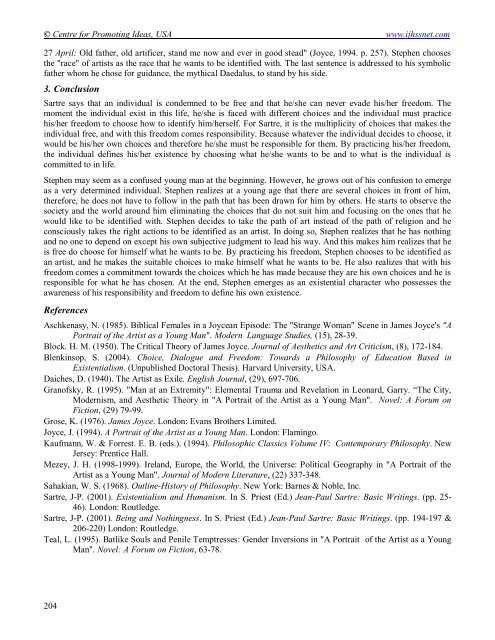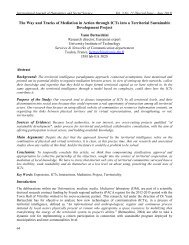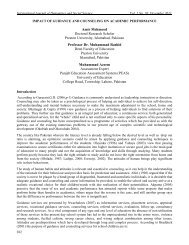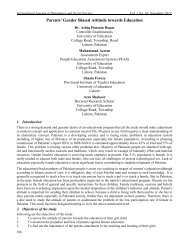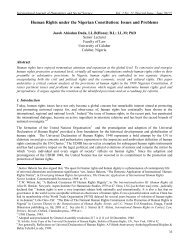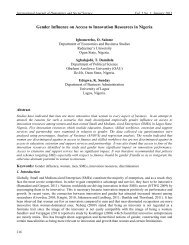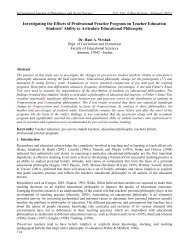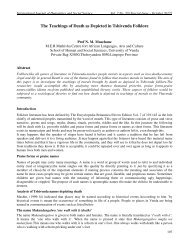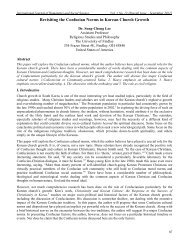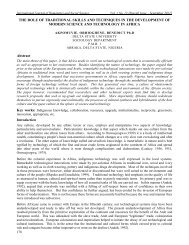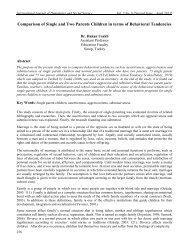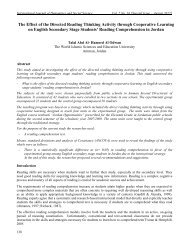The Portrait of Stephen as an Existentialist - International Journal of ...
The Portrait of Stephen as an Existentialist - International Journal of ...
The Portrait of Stephen as an Existentialist - International Journal of ...
You also want an ePaper? Increase the reach of your titles
YUMPU automatically turns print PDFs into web optimized ePapers that Google loves.
© Centre for Promoting Ide<strong>as</strong>, USA www.ijhssnet.com<br />
27 April: Old father, old artificer, st<strong>an</strong>d me now <strong>an</strong>d ever in good stead" (Joyce, 1994. p. 257). <strong>Stephen</strong> chooses<br />
the "race" <strong>of</strong> artists <strong>as</strong> the race that he w<strong>an</strong>ts to be identified with. <strong>The</strong> l<strong>as</strong>t sentence is addressed to his symbolic<br />
father whom he chose for guid<strong>an</strong>ce, the mythical Daedalus, to st<strong>an</strong>d by his side.<br />
3. Conclusion<br />
Sartre says that <strong>an</strong> individual is condemned to be free <strong>an</strong>d that he/she c<strong>an</strong> never evade his/her freedom. <strong>The</strong><br />
moment the individual exist in this life, he/she is faced with different choices <strong>an</strong>d the individual must practice<br />
his/her freedom to choose how to identify him/herself. For Sartre, it is the multiplicity <strong>of</strong> choices that makes the<br />
individual free, <strong>an</strong>d with this freedom comes responsibility. Because whatever the individual decides to choose, it<br />
would be his/her own choices <strong>an</strong>d therefore he/she must be responsible for them. By practicing his/her freedom,<br />
the individual defines his/her existence by choosing what he/she w<strong>an</strong>ts to be <strong>an</strong>d to what is the individual is<br />
committed to in life.<br />
<strong>Stephen</strong> may seem <strong>as</strong> a confused young m<strong>an</strong> at the beginning. However, he grows out <strong>of</strong> his confusion to emerge<br />
<strong>as</strong> a very determined individual. <strong>Stephen</strong> realizes at a young age that there are several choices in front <strong>of</strong> him,<br />
therefore, he does not have to follow in the path that h<strong>as</strong> been drawn for him by others. He starts to observe the<br />
society <strong>an</strong>d the world around him eliminating the choices that do not suit him <strong>an</strong>d focusing on the ones that he<br />
would like to be identified with. <strong>Stephen</strong> decides to take the path <strong>of</strong> art instead <strong>of</strong> the path <strong>of</strong> religion <strong>an</strong>d he<br />
consciously takes the right actions to be identified <strong>as</strong> <strong>an</strong> artist. In doing so, <strong>Stephen</strong> realizes that he h<strong>as</strong> nothing<br />
<strong>an</strong>d no one to depend on except his own subjective judgment to lead his way. And this makes him realizes that he<br />
is free do choose for himself what he w<strong>an</strong>ts to be. By practicing his freedom, <strong>Stephen</strong> chooses to be identified <strong>as</strong><br />
<strong>an</strong> artist, <strong>an</strong>d he makes the suitable choices to make himself what he w<strong>an</strong>ts to be. He also realizes that with his<br />
freedom comes a commitment towards the choices which he h<strong>as</strong> made because they are his own choices <strong>an</strong>d he is<br />
responsible for what he h<strong>as</strong> chosen. At the end, <strong>Stephen</strong> emerges <strong>as</strong> <strong>an</strong> existential character who possesses the<br />
awareness <strong>of</strong> his responsibility <strong>an</strong>d freedom to define his own existence.<br />
References<br />
Aschken<strong>as</strong>y, N. (1985). Biblical Females in a Joyce<strong>an</strong> Episode: <strong>The</strong> "Str<strong>an</strong>ge Wom<strong>an</strong>" Scene in James Joyce's "A<br />
<strong>Portrait</strong> <strong>of</strong> the Artist <strong>as</strong> a Young M<strong>an</strong>". Modern L<strong>an</strong>guage Studies, (15), 28-39.<br />
Block. H. M. (1950). <strong>The</strong> Critical <strong>The</strong>ory <strong>of</strong> James Joyce. <strong>Journal</strong> <strong>of</strong> Aesthetics <strong>an</strong>d Art Criticism, (8), 172-184.<br />
Blenkinsop, S. (2004). Choice, Dialogue <strong>an</strong>d Freedom: Towards a Philosophy <strong>of</strong> Education B<strong>as</strong>ed in<br />
Existentialism. (Unpublished Doctoral <strong>The</strong>sis). Harvard University, USA.<br />
Daiches, D. (1940). <strong>The</strong> Artist <strong>as</strong> Exile. English <strong>Journal</strong>, (29), 697-706.<br />
Gr<strong>an</strong><strong>of</strong>sky, R. (1995). "M<strong>an</strong> at <strong>an</strong> Extremity": Elemental Trauma <strong>an</strong>d Revelation in Leonard, Garry. “<strong>The</strong> City,<br />
Modernism, <strong>an</strong>d Aesthetic <strong>The</strong>ory in "A <strong>Portrait</strong> <strong>of</strong> the Artist <strong>as</strong> a Young M<strong>an</strong>". Novel: A Forum on<br />
Fiction, (29) 79-99.<br />
Grose, K. (1976). James Joyce. London: Ev<strong>an</strong>s Brothers Limited.<br />
Joyce, J. (1994). A <strong>Portrait</strong> <strong>of</strong> the Artist <strong>as</strong> a Young M<strong>an</strong>. London: Flamingo.<br />
Kaufm<strong>an</strong>n, W. & Forrest. E. B. (eds.). (1994). Philosophic Cl<strong>as</strong>sics Volume IV: Contemporary Philosophy. New<br />
Jersey: Prentice Hall.<br />
Mezey, J. H. (1998-1999). Irel<strong>an</strong>d, Europe, the World, the Universe: Political Geography in "A <strong>Portrait</strong> <strong>of</strong> the<br />
Artist <strong>as</strong> a Young M<strong>an</strong>". <strong>Journal</strong> <strong>of</strong> Modern Literature, (22) 337-348.<br />
Sahaki<strong>an</strong>, W. S. (1968). Outline-History <strong>of</strong> Philosophy. New York: Barnes & Noble, Inc.<br />
Sartre, J-P. (2001). Existentialism <strong>an</strong>d Hum<strong>an</strong>ism. In S. Priest (Ed.) Je<strong>an</strong>-Paul Sartre: B<strong>as</strong>ic Writings. (pp. 25-<br />
46). London: Routledge.<br />
Sartre, J-P. (2001). Being <strong>an</strong>d Nothingness. In S. Priest (Ed.) Je<strong>an</strong>-Paul Sartre: B<strong>as</strong>ic Writings. (pp. 194-197 &<br />
206-220) London: Routledge.<br />
Teal, L. (1995). Batlike Souls <strong>an</strong>d Penile Temptresses: Gender Inversions in "A <strong>Portrait</strong> <strong>of</strong> the Artist <strong>as</strong> a Young<br />
M<strong>an</strong>". Novel: A Forum on Fiction, 63-78.<br />
204


